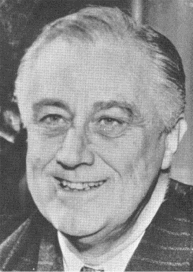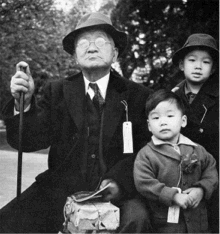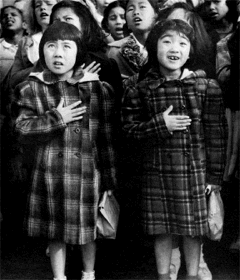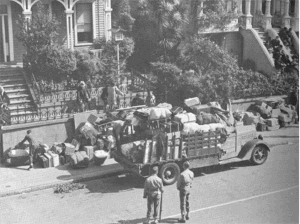


| Evacuation |



| On February nineteenth, 1942 President Roosevelt signed Executive Order 9066, two months and twelve days after Pearl Harbor. This enabled the military to evacuate Japanese Americans from the West Coast. Although there had been no further Japanese aggression, the US still considered the Japanese Americans to be a security issue. In light of the racism on the West coast, it was politically expedient after Pearl Harbor to take action on the Japanese American 'problem'. The successful Japanese attack on the American naval base in Hawaii struck fear in the American population, how had a supposedly inferior race achieved such an overwhelming victory? It was ignorantly assumed that the Japanese must have been helped, and the obvious traitors were Japanese Americans, of which, a large number lived in Hawaii. |
 |
The fears, however irrational and misinformed were very real. The public were demanding action, and were incensed by a sensationalist media. In fact there had been no acts of Japanese American treason, and there never would be throughout the war. Despite evidence to the contrary, in the Munson Report, the Army and government alike feared the consequences of no action being taken about the Japanese American problem. More |
| General DeWitt had been an important military spokesperson for the evacuation of enemy aliens since December 1941. On March the second, 1942, DeWitt announced the demarcation of two military zones. Military Area No. 1 included the western parts of Washington, Oregon and California and southern Arizona. Military Area No. 2 was to cover the eastern parts of the coastal states, and northern Arizona. Japanese Americans were informed that their formal evacuation of Military Area No. 1 would soon follow, and until that point they were advised to move into the interior voluntarily. More |
| On March the eleventh the Wartime Civil Control Administration was created to cope with the evacuation program. Once informed that they were to be evacuated from their homes, Japanese Americans had very little time to prepare themselves to leave their homes, for an indefinite period, and to an unknown destination. |  |
 |
Therefore this led to potential for exploitation because whites took advantage of Japanese Americans desperate to sell their property and businesses. Sadly they often only received only a small proportion of the actual worth for their possessions. Sometimes possessions had to be literally abandoned. |
| Some Americans promised to look after Japanese American's belongings, but sold them instead, while others bought Japanese American's business's and sold as much as triple the price they originally paid for them. It should not be believed that all Americans were racist. |

Uchida, A Desert Exile, pg.65 Evacuation |
Some Japanese Americans returned from internment camps to have their belongings and business returned to them. Masaji Kusachi remembered when they returned from the camps, their white neighbors had looked after some of their belongings: "everything (was) in there just as I put it: the papers the documents and all the other valuable things. Nothing was missing." (Okihiro Whispered silences 231.) |